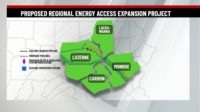At ground zero for Hurricane Sandy landfall late on Oct. 29, New Jersey is reeling from the impact.
Four Jersey shore towns “are almost completely under water,” said NJ Gov. Christopher Christie at an Oct. 30 press briefing. The towns he referred to are Lavalette, Seaside Heights, Sea Bright and Belmar. “The devastation is unthinkable.” He said an aerial tour of the especially hard hit barrier islands would be difficult to impossible because of lack of space to land a plane.
Major state arteries were closed on Oct. 29.
The New Jersey Turnpike has reopened south of exit 14, according to the NJ Turnpike Authority.
However, both the eastern and western spurs of the Turnpike north of exit 14 remain closed due to chlorine fumes in Kearny from a fire at a chlorine storage facility.
Christie noted “significant tidal flooding” in Jersey City, Secaucus, Newark, Sayreville and Moonachie.
He added that a surge “picked up” freight rail cars and deposited them on a ramp of the NJ Turnpike. Another ramp suffered a “large washout,” he said.
Christie said a number of NJ counties have been designated disaster areas and are eligible for FEMA funds. President Obama had contacted him, Christie said.
“There is major damage on each and every rail line in NJ,” Christie said, noting “major sections washed out on the NJ Coastline that goes along the Jersey shore.
Christie noted issues “from minor to major” at the state’s 10 drinking water facilities and 13 wastewater treatment plants, related to flooding or power loss or both.
About 2.2 million NJ customers remain without power, 1.4 million served by utility PSE&G, “making it the largest storm in PSE&G history,” says the utility.
He noted tidal surge damage to substations in Newark that left most of the city without power on Tuesday.
Noting that power restoration took about eight days after Hurricane Irene in August 2011, post-Sandy restoration “will take much longer,” Christie said.
PSE&G said “The walls of water created by the storm surge flooded a large number of stations along the Passaic, Raritan and Hudson rivers, disrupting service for about 462,000 customers in Hudson, Essex and Middlesex counties. The magnitude of the flooding in contiguous areas is unprecedented.
“PSE&G had to take these stations out of service and will have to wait for the flood waters to recede before we can assess the damage, dry out the equipment, replace equipment when necessary and re-energize the system to restore service,” said utility President Ralph LaRossa. “It will be a slow, painstaking process.”
Crews helping in the restoration efforts have come from Texas, Indiana, Illinois, Wisconsin, Florida, Missouri, Pennsylvania, Tennessee, Georgia and New Jersey, as well as Canada.
“Given the destructive nature of this storm, however, some customers may be without service for seven or more days. Our urban centers were especially hard hit as a result of substation flooding. One of our first priorities is to get those stations back in service."




Post a comment to this article
Report Abusive Comment